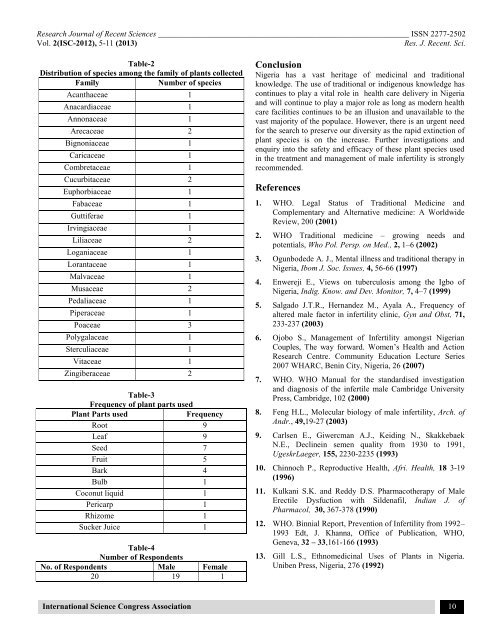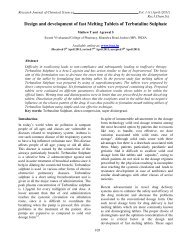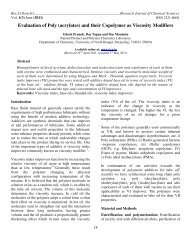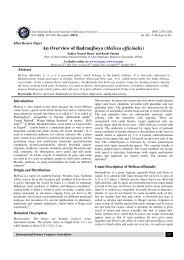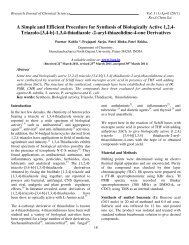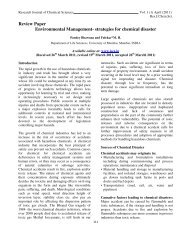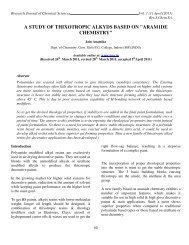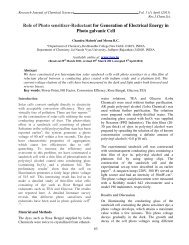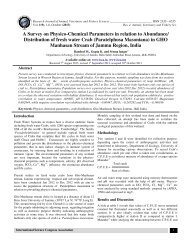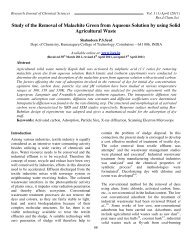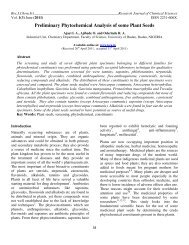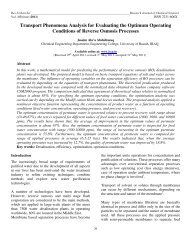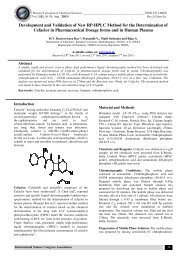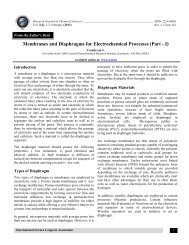Ethnomedicinal Survey of Medicinal Plants Used in the ... - ISCA
Ethnomedicinal Survey of Medicinal Plants Used in the ... - ISCA
Ethnomedicinal Survey of Medicinal Plants Used in the ... - ISCA
Create successful ePaper yourself
Turn your PDF publications into a flip-book with our unique Google optimized e-Paper software.
Research Journal <strong>of</strong> Recent Sciences ______________________________________________________________ ISSN 2277-2502<br />
Vol. 2(ISC-2012), 5-11 (2013)<br />
Res. J. Recent. Sci.<br />
Table-2<br />
Distribution <strong>of</strong> species among <strong>the</strong> family <strong>of</strong> plants collected<br />
Family<br />
Number <strong>of</strong> species<br />
Acanthaceae 1<br />
Anacardiaceae 1<br />
Annonaceae 1<br />
Arecaceae 2<br />
Bignoniaceae 1<br />
Caricaceae 1<br />
Combretaceae 1<br />
Cucurbitaceae 2<br />
Euphorbiaceae 1<br />
Fabaceae 1<br />
Guttiferae 1<br />
Irv<strong>in</strong>giaceae 1<br />
Liliaceae 2<br />
Loganiaceae 1<br />
Lorantaceae 1<br />
Malvaceae 1<br />
Musaceae 2<br />
Pedaliaceae 1<br />
Piperaceae 1<br />
Poaceae 3<br />
Polygalaceae 1<br />
Sterculiaceae 1<br />
Vitaceae 1<br />
Z<strong>in</strong>giberaceae 2<br />
Table-3<br />
Frequency <strong>of</strong> plant parts used<br />
Plant Parts used<br />
Frequency<br />
Root 9<br />
Leaf 9<br />
Seed 7<br />
Fruit 5<br />
Bark 4<br />
Bulb 1<br />
Coconut liquid 1<br />
Pericarp 1<br />
Rhizome 1<br />
Sucker Juice 1<br />
Table-4<br />
Number <strong>of</strong> Respondents<br />
No. <strong>of</strong> Respondents Male Female<br />
20 19 1<br />
Conclusion<br />
Nigeria has a vast heritage <strong>of</strong> medic<strong>in</strong>al and traditional<br />
knowledge. The use <strong>of</strong> traditional or <strong>in</strong>digenous knowledge has<br />
cont<strong>in</strong>ues to play a vital role <strong>in</strong> health care delivery <strong>in</strong> Nigeria<br />
and will cont<strong>in</strong>ue to play a major role as long as modern health<br />
care facilities cont<strong>in</strong>ues to be an illusion and unavailable to <strong>the</strong><br />
vast majority <strong>of</strong> <strong>the</strong> populace. However, <strong>the</strong>re is an urgent need<br />
for <strong>the</strong> search to preserve our diversity as <strong>the</strong> rapid ext<strong>in</strong>ction <strong>of</strong><br />
plant species is on <strong>the</strong> <strong>in</strong>crease. Fur<strong>the</strong>r <strong>in</strong>vestigations and<br />
enquiry <strong>in</strong>to <strong>the</strong> safety and efficacy <strong>of</strong> <strong>the</strong>se plant species used<br />
<strong>in</strong> <strong>the</strong> treatment and management <strong>of</strong> male <strong>in</strong>fertility is strongly<br />
recommended.<br />
References<br />
1. WHO. Legal Status <strong>of</strong> Traditional Medic<strong>in</strong>e and<br />
Complementary and Alternative medic<strong>in</strong>e: A Worldwide<br />
Review, 200 (2001)<br />
2. WHO Traditional medic<strong>in</strong>e – grow<strong>in</strong>g needs and<br />
potentials, Who Pol. Persp. on Med., 2, 1–6 (2002)<br />
3. Ogunbodede A. J., Mental illness and traditional <strong>the</strong>rapy <strong>in</strong><br />
Nigeria, Ibom J. Soc. Issues, 4, 56-66 (1997)<br />
4. Enwereji E., Views on tuberculosis among <strong>the</strong> Igbo <strong>of</strong><br />
Nigeria, Indig. Know. and Dev. Monitor, 7, 4–7 (1999)<br />
5. Salgado J.T.R., Hernandez M., Ayala A., Frequency <strong>of</strong><br />
altered male factor <strong>in</strong> <strong>in</strong>fertility cl<strong>in</strong>ic, Gyn and Obst, 71,<br />
233-237 (2003)<br />
6. Ojobo S., Management <strong>of</strong> Infertility amongst Nigerian<br />
Couples, The way forward. Women’s Health and Action<br />
Research Centre. Community Education Lecture Series<br />
2007 WHARC, Ben<strong>in</strong> City, Nigeria, 26 (2007)<br />
7. WHO. WHO Manual for <strong>the</strong> standardised <strong>in</strong>vestigation<br />
and diagnosis <strong>of</strong> <strong>the</strong> <strong>in</strong>fertile male Cambridge University<br />
Press, Cambridge, 102 (2000)<br />
8. Feng H.L., Molecular biology <strong>of</strong> male <strong>in</strong>fertility, Arch. <strong>of</strong><br />
Andr., 49,19-27 (2003)<br />
9. Carlsen E., Giwercman A.J., Keid<strong>in</strong>g N., Skakkebaek<br />
N.E., Decl<strong>in</strong>e<strong>in</strong> semen quality from 1930 to 1991,<br />
UgeskrLaeger, 155, 2230-2235 (1993)<br />
10. Ch<strong>in</strong>noch P., Reproductive Health, Afri. Health, 18 3-19<br />
(1996)<br />
11. Kulkani S.K. and Reddy D.S. Pharmaco<strong>the</strong>rapy <strong>of</strong> Male<br />
Erectile Dysfuction with Sildenafil, Indian J. <strong>of</strong><br />
Pharmacol, 30, 367-378 (1990)<br />
12. WHO. B<strong>in</strong>nial Report, Prevention <strong>of</strong> Infertility from 1992–<br />
1993 Edt, J. Khanna, Office <strong>of</strong> Publication, WHO,<br />
Geneva, 32 – 33,161-166 (1993)<br />
13. Gill L.S., <strong>Ethnomedic<strong>in</strong>al</strong> Uses <strong>of</strong> <strong>Plants</strong> <strong>in</strong> Nigeria.<br />
Uniben Press, Nigeria, 276 (1992)<br />
International Science Congress Association 10


